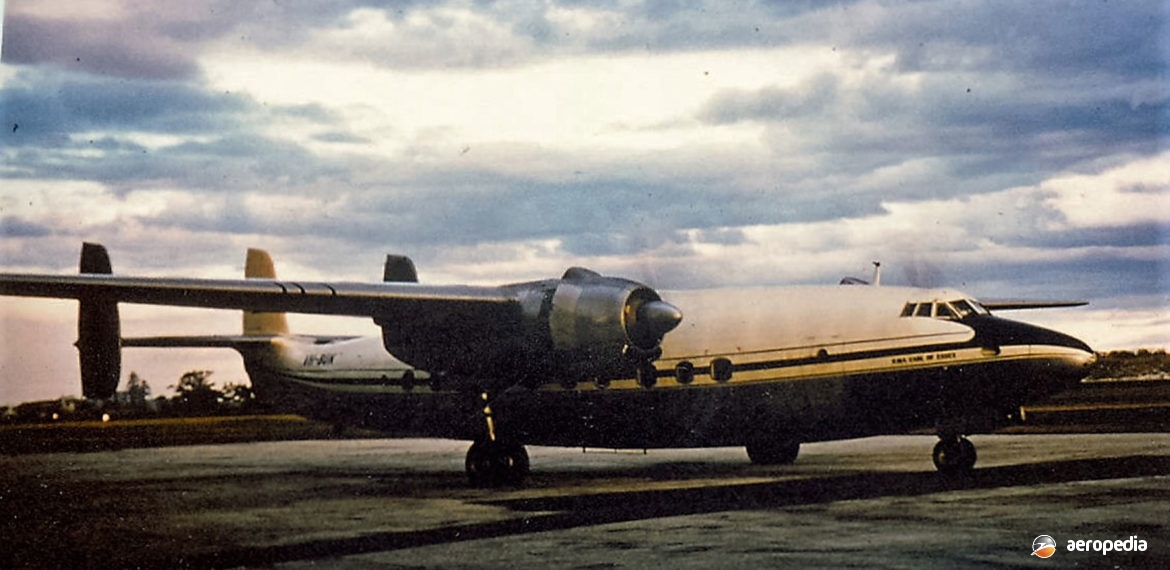Photograph:
Butler Airways Airspeed Ambassador VH-BUK (c/n 5227) at Mascot, NSW in 1958 (David C Eyre)
Country of origin:
United Kingdom
Description:
Commercial airliner
Power Plant:
Two 1,940 kw (2,600 hp) Bristol Centaurus 661 eighteen-cylinder, two-row, sleeve-valve two-speed supercharged air-cooled radial engines
Specifications:
- Wingspan: 35.05 m (115 ft)
- Length: 24.69 m (81 ft)
- Height: 5.57 m (18 ft 4 in)
- Wing area: 111.48 m² (1,200 sq ft)
- Max speed: 502 km/h (312 mph)
- Max cruising speed at 6,096 m (20,000 ft) at 22,680 kg (50,000 lb): 483 km/h (300 mph)
- Normal rate of climb: at 1,524 m (5,000 ft) at max weight 463 m/min (1,520 ft/min)
- Ceiling: 4,572 m (15,000 ft)
- Range at 450 km/h (280 mph): 1,159 km (720 miles)
- Range at 354 km/h (220 mph) with max fuel: 3,138 km (1,950 miles)
- Fuel capacity: 4,546 litres (1,000 Imp gals)
- Empty weight: 16,277 kg (35,884 lb)
- Disposable load: 7,310 kg (16,116 lb)
- Loaded weight: 23,587 kg (52,000 lb)
History:
One of the most graceful and elegant airliners built, known as the Elizabethan Class, the Airspeed AS-57 Ambassador was designed by a team headed by A E (Arthur) Hagg. A twin-engine high-wing cantilever monoplane with a retractable nosewheel undercarriage and triple fins, the type was of all-metal construction and pressurised.
The prototype G-AGUA (c/n 61) made its first flight at Christchurch in Dorset, UK on 10 July 1947, making its first public debut at the Farnborough Air Show in September of that year, followed by the second prototype G-AKRD (c/n 62) on 26 August 1948. A total of 23 aircraft was built, comprising two Ambassador Is, being the two prototypes, and 21 Ambassador 2s. A proposed variant was the AS.60 Ayrshire, a military transport with ‘clamshell’ loading doors at the rear of the fuselage. The wing was built to achieve laminar flow, the fuselage being streamlined to give it dynamic stability. It was said it was very easy to fly on one engine.
At one stage in 1951 Australian National Airways and Trans Australian Airlines were both considering the purchase of the type. Indian and New Zealand operators were said to be interested, but, as production had ceased after the completion of an order for BEA, no order was forthcoming as most airlines by that time had become interested in obtaining the four-engine Vickers Viscount. At the 1948 Farnborough Air Show an Ambassador was demonstrated taking-off, making a circuit, and landing on one engine. This was done as a demonstration of how safe a twin-engine aircraft it was.
In 1957 Butler Air Transport, which was flying its Vickers Viscounts (VH-BAT and VH-BUT) on intra-state services in NSW, was looking for another type due to the damage the Viscounts were occasioning to country NSW sealed runways, particularly Coffs Harbour. The Company then bought three ex-British European Airways Elizabethans, as they were known: VH-BUI (c/n 5220 – ex G-ALZX – Sir John Norris); VH-BUK (c/n 5227 – ex G-AMAE – Earl of Essex); and VH-BUJ (c/n 5230 – ex G-AMAH – Sir Christopher Hatton).
It was hoped the type would take over from Douglas DC-3s on all Butler routes. First fare paying passengers were carried on 5 August 1957. The three aircraft were flown to Australia by BEA crews, arriving at Mascot, NSW on 18 June 1957, these crews remaining in Australia for a period to train Butler crews.
Towns visited by the Ambassadors in Australian service included, in New South Wales, Walgett, Coonamble, Dubbo, Parkes, Bourke, Casino, Coffs Harbour, Broken Hill, and Nyngan; and in southern Queensland, Cunnamulla, Toowoomba and Coolangatta. One VH-BUK had an accident at Canberra, ACT on 1 March 1958 when “whilst simulating engine failure during a flapless take-off, the aircraft sank back onto the runway with the undercarriage retracted due to the undercarriage being raised before the aircraft was safely airborne”. It was soon lifted, the undercarriage was put down, and the aircraft was repaired and returned to service.
However, at about this time Ansett Airlines had taken control of ANA to form Ansett-ANA. Efforts were then made to gain control of Butler Air Transport and these succeeded in February 1958. Ansett was then keen to rationalise its fleet, indicating the Convair 340 and 440 were series more suitable for its routes. An arrangement was entered into with BEA and the Ambassadors were withdrawn from service in August 1958 and flown back to the UK where they took up their former registrations and entered service with Dan Air, the aircraft being flown back to the United Kingdom with 15 stops in a time of 65 hours. G-ALZX was damaged in an accident in April 1966 and was repaired; G-AMAE and G-AMAH were withdrawn and broken up in 1971.
Largest operators of the type were Dan Air (10) and British European Airways (20). Two were operated for a period by the Royal Jordanian Air Force. Some records have indicate that one G-ALZP (c/n 5213) went to the King of Morocco as CN-MAK and then to New Zealand as ZK-DFC. It would appear this machine was operated by Decca from West Malling as a VIP/navaid demonstrator. After 1970 it was retired, it having during its time with Decca, visited the United States in 1964 for a ten-week tour where it earned the nicknames ‘de Havilland Zee Pee’ and ‘twin engine Connie’.
G-ALZP was kept airworthy and in 1971 South Seas Airways of Wellington, New Zealand sought to buy the aircraft and convert it back to its 47 seat configuration. However, the sale did not materialise and, after a last flight on 9 June 1971, it was scrapped.
One Ambassador G-ALFR (G.37-4), the first production prototype, was tested for a period with Napier NEI.I Eland turboprops. One Ambassador survives in the UK, this aircraft G-ALZO (c/n 5226) being owned by the Duxford Aviation Society and having been restored for display.

